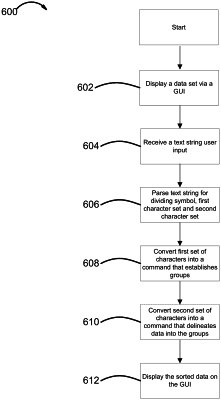| CPC G06F 40/205 (2020.01) [G06F 7/24 (2013.01); G06F 40/166 (2020.01); G06F 40/284 (2020.01)] | 20 Claims |

|
1. A method of converting user input into a standardized input, comprising:
receiving via a user input a string including a first set of characters and a second set of characters positioned on either side of a dividing symbol;
converting the first set of characters into a first standardized input that establishes a scope of a plurality of items of a data set to sort into a number of groups based on a numerically sortable attribute of the data set, the first standardized input also establishing the number of groups;
converting the second set of characters into a second standardized input that establishes how to delineate the plurality of items of the data set into the number of groups based on the numerically sortable attribute of the data set, the second standardized input also establishing a scale of ranges of a set of the plurality of items of the data set to be sorted into each group; and
displaying, on a graphic user interface, the number of groups as established by the first standardized input, each group populated by a subset of the set of the plurality of items of the data set as delineated by the second standardized input.
|